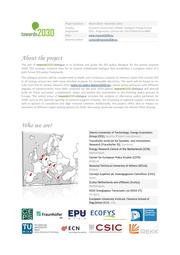File:Report on Identification and Qualitative Analysis of Target Setting Options.pdf
 Size of this JPG preview of this PDF file: 424 × 600 pixels. Other resolution: 170 × 240 pixels. |
Original file (2,480 × 3,508 pixels, file size: 0 bytes, MIME type: application/pdf, 29 pages)
Summary
| Description |
English: Even though a greenhouse gas (GHG) emissions reduction target for 2030 is not formally agreed upon by Member States yet, this analysis assumes that a future target structure for the EU will be built on at least a binding GHG target. Other target options always encompass a GHG target combined with some more detailed sub‐target(s).
In this section, a selection of target frameworks resulting from combination of the design elements in Fehler! Verweisquelle konnte nicht gefunden werden. will be described in more detail. The selection has been based on which target framework options have been or are currently relevant in the policy discussion. The focus here is on the target structure itself (blue design elements). In a second step, the selected target structures are assessed according to a number of criteria. Burden sharing options (red design elements) will be discussed in the next section. The current European energy and climate policy framework centres on the “20‐20‐20” headline targets to be achieved by 2020 (European Commission 2014a): A reduction of GHG emissions by 20% compared to 1990 levels; a share of 20% RES in gross final energy consumption; and a 20% improvement in energy efficiency. This bundle of targets was agreed upon by the EU Member States in 2007 under the German council presidency (Geden & Fischer 2014). Recent political discussions have revolved mainly around the question of whether this framework ought to be continued or whether further RES and efficiency tar‐ gets would be unnecessary for 2030. However, for the sake of a more comprehensive view, other possi‐ ble target structures are explained here as well. The focus here is on the existence or non‐existence of a RES target. Possibilities for an efficiency target are discussed where they are directly linked to the RES target.
|
|---|---|
| Source |
Own Work |
| Date |
2015-10-20 |
| Author | |
| Permission |
See license tag below. |
Licensing
|
File history
Click on a date/time to view the file as it appeared at that time.
| Date/Time | Thumbnail | Dimensions | User | Comment | |
|---|---|---|---|---|---|
| current | 13:40, 20 October 2015 |  | 2,480 × 3,508, 29 pages (0 bytes) | ***** (***** | *****) | User created page with UploadWizard |
You cannot overwrite this file.
File usage
The following page uses this file:




















